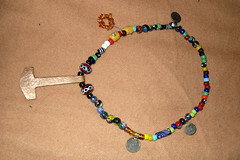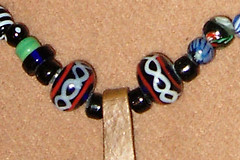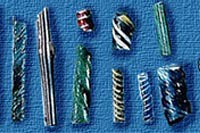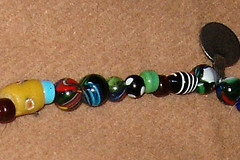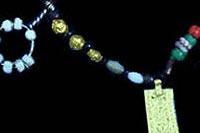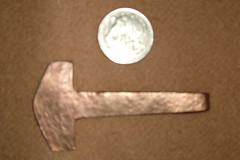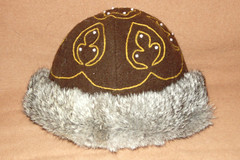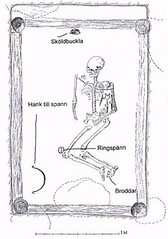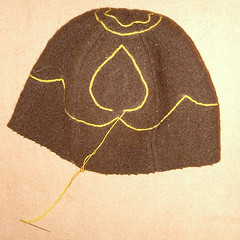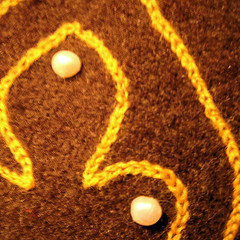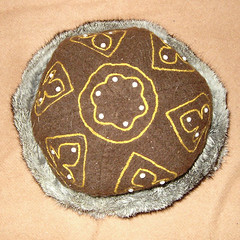The Vikings loved their colourful glass beads and different findings and sometimes pieced them together to form muddled necklaces full of colour and "treasures".
Difficulty: Easy
Total Time: 2 Hours
Documentation
Finding beads today that would have been available during the Viking era can be a daunting task. I went to a local bead shop armed with colour print-outs from various websites and spent a good hour looking through different beads and picking out a couple here, one there, a half dozen somewhere else. Some beads I even found on e-bay and had them shipped specially.
These are just a small selection of beads which I managed to find replicas for today (extant on left):
The large red, white and black bead is similar to the ones from the necklace manufactured in Scandinavia c 800 to 1000 CE. This extant necklace also includes some millefiore beads, demonstrating that this type is not post-rennaisance.
The glass debris displayed here were found in a Viking Age glass-worker's shop in Ribe, Denmark and are reminiscent to several that I included on my necklace. This segment of my design also shows millefiore beads and an eye bead.
This is a 9th cent. treasure necklace from the hoard from Hon in Norway. It is special in that it contains many golden pieces, whereas most featured silver items. I am displaying a segment that includes gold foil beads , a pendant of glass beads woven onto wire, and a pendant hanging from an attached loop. My design includes gold foil beads and a pendant with amber (later removed in favour of a fourth coin pendant), but shown is an old Islamic coin (1920's?) made into a pendant.
Hammers of this general type were distributed widely. They were cut from a single sheet, and the top was bent over to form the loop. The one I re-created is modeled after one found in Hesselbjerg, Denmark and I made it out of a piece of brass. The basic shape was cut with tin snips, then the edges were filed smooth. Next we used a hammer to "weather" the brass and make a little loop at the top and lastly it was polished. Pictured is my re-creation with an Australian 20 cent piece and the hammer on the necklace.
Construction
The difficult thing about constructing a treasure necklace is to throw away all of our modern concepts of form, colour and symmetry. The Vikings prized a mixture of colours and collected many types of beads and items converted to serve as pendants.
The Viking Answer Lady offers directions for the construction of a treasure necklace and we shall follow them.
Step One: Arrange special beads and pendants
I started by laying out the coin pendants and the special Thor's Hammer in a rough circle on my table in approximate distances from each other.
Step Two: Make more pendants if desired with beads and wire
I created a pendant by stringing tiny amber chips onto a length of wire and then twisting the ends together to form a "stalk" which is used as the loop of the pendant. This technique seems to be used mainly to highlight a group of special beads - either the same colour, or ones that are more precious or loved than the others.
Step Three: Place pairs of beads 180° apart across the necklace
Pick up pairs of beads that are similar in size, shape and tone (dark or light) and place them approximately 180° apart across the circle. The beads do not have to be exactly the same colour.
Step Four: Create some short patterns and place remainder beads
Pendants were often emphasised with short patterns, or the same type of bead either side of them. I constructed patterns using my special gold foil beads, or in the case of the Thor's Hammer, by setting it off with my large glass beads. I also set off pendants by using the same colour and type of bead to either side of it.
Step Six: Pick a point and string your necklace
I picked the point I thought would be at the back of the neck to string my necklace. I threaded it on a heavy linen thread that I waxed prior to stringing.
Additional Resources
Thor's Hammer - Extant Photos
The Viking Answer Lady - Viking Beads
Monday, February 28, 2005
Thursday, February 10, 2005
Rus Hat
If you are camping or spending time re-enacting in the colder months, then one essential piece of kit is a nice warm hat. This hat is completely fur lined, covers the ears and can be decorated in a variety of ways for a personal touch.
Difficulty: Medium-Hard
Total Time: 6 Hours non decorated (40-50 hours decorated)
According to one of the theories about the head-gear from Birka, hats display military rank. The pointed hats with gold ornaments may represent the highest rank, the rounded with silver ornaments a middle rank, and the rounded without any ornaments the lowest in rank.
The Birka grave 958 also shows what is probably a rounded or dome shape hat as shown in the picture from Arbmans "Birka - die Gräber", page 383.
Step One: Make a pattern from the basic shape to suit your desired size.
Measuring the head where the hat will sit (round up to the nearest inch). Divide this number by six - this is the width of your pattern. Next measure the length fron one side of the hat to the other (ear to ear over the top of your head) and divide this number by two - this is the height of your pattern. Draw a line to connect these two points Allow 1cm all the way around and cut out your new pattern.
Step Two: Cut six pieces of wool and sew together.
You can test your hat pattern first at this stage using some scrap material. Remember that you will have fur lining on the inside, so it should not be too snug at this stage as you need an allowance for the fur lining. If you find at the end that your hat is fitting snug, it does stretch out a little though. My hat is reasonably snug, but still comfortable to wear.
After cutting my six panels I sewed each side together using a basic running stitch. (You can start work on step four as well if you wish)
On the inside of all my seams I like to use a period seam treatment. I did this on the inside of the hat as it allows each panel to sit nice and flat and also creates a nice even dome for any decorations you wish to add.


Step Three: Design and sew your embroidery and any other additions.
The embroidery patterns I used are from a Russian book on extant items, including textiles, household items, weapons and many other things. It is a simple pattern, which I recreated in gold wool and accented with white cultured pearls.
Step Four: Cut 6 fur pieces 10cm longer than your wool pattern and sew.
You may need to cut a new pattern to help you cut your fur. Instead of adding a 1cm allowance you only need approximately 2mm for the fur. When cutting fur you should keep the fur direction the same way for each panel. In order to get a nice fluffy edge you also need to look at the direction when the fur is folded. I cut mine so that the fur was pointing away from the pointed end of the pattern. To cut the fur without damaging the folicles use either a craft knife on the leather side or small embroidery scissors with sharp points that can get between the fur. If you cut through the fur folicles you may be unhappy with the finish.
Sew each panel together using a thread such as linen. If you are using recycled fur, such as an old fur coat, then be careful the threads do not tear the leather. You may have to re-enforce spots.
Step Five: Tack the wool to the fur to keep its basic shape.
Fixing the fur and the wool parts together is probably the hardest step, though not the most time consuming. I started by tacking the two domes together at the points, then adding another line of tacking about 5-10 cm from the point around the dome. I then tacked the bottom of the wool to the fur ready for turning the fur band evenly.
Step Six: Sew fur to wool around the top of the band.
Fold your fur around to the desired height on your wool. I found that I had enough to fold over and back under again giving me in practicality three layers of fur where the band is.
Sew the fur to the wool around the edge of the band, and then using your needle carefully lever out any fur that got sewn into the band so you have a nice even fluffy edge.
Additional Resources
Hat pattern base and Birka grave find image from Historiska världar
Example of pattern use by Þóra Sharptooth
Fur trimmed hats from Eastern Europe and Central Asia by The Renaissance Tailor
Easter 2005: This hat won second prize in the clothing category of an Arts & Sciences competition at the XIIIth ARC (Australian Re-enactors Conferention) despite me not having any of my documentation to submit with it
Difficulty: Medium-Hard
Total Time: 6 Hours non decorated (40-50 hours decorated)
According to one of the theories about the head-gear from Birka, hats display military rank. The pointed hats with gold ornaments may represent the highest rank, the rounded with silver ornaments a middle rank, and the rounded without any ornaments the lowest in rank.
The Birka grave 958 also shows what is probably a rounded or dome shape hat as shown in the picture from Arbmans "Birka - die Gräber", page 383.
Step One: Make a pattern from the basic shape to suit your desired size.
Measuring the head where the hat will sit (round up to the nearest inch). Divide this number by six - this is the width of your pattern. Next measure the length fron one side of the hat to the other (ear to ear over the top of your head) and divide this number by two - this is the height of your pattern. Draw a line to connect these two points Allow 1cm all the way around and cut out your new pattern.
Step Two: Cut six pieces of wool and sew together.
You can test your hat pattern first at this stage using some scrap material. Remember that you will have fur lining on the inside, so it should not be too snug at this stage as you need an allowance for the fur lining. If you find at the end that your hat is fitting snug, it does stretch out a little though. My hat is reasonably snug, but still comfortable to wear.
After cutting my six panels I sewed each side together using a basic running stitch. (You can start work on step four as well if you wish)
On the inside of all my seams I like to use a period seam treatment. I did this on the inside of the hat as it allows each panel to sit nice and flat and also creates a nice even dome for any decorations you wish to add.


Step Three: Design and sew your embroidery and any other additions.
The embroidery patterns I used are from a Russian book on extant items, including textiles, household items, weapons and many other things. It is a simple pattern, which I recreated in gold wool and accented with white cultured pearls.
Step Four: Cut 6 fur pieces 10cm longer than your wool pattern and sew.
You may need to cut a new pattern to help you cut your fur. Instead of adding a 1cm allowance you only need approximately 2mm for the fur. When cutting fur you should keep the fur direction the same way for each panel. In order to get a nice fluffy edge you also need to look at the direction when the fur is folded. I cut mine so that the fur was pointing away from the pointed end of the pattern. To cut the fur without damaging the folicles use either a craft knife on the leather side or small embroidery scissors with sharp points that can get between the fur. If you cut through the fur folicles you may be unhappy with the finish.
Sew each panel together using a thread such as linen. If you are using recycled fur, such as an old fur coat, then be careful the threads do not tear the leather. You may have to re-enforce spots.
Step Five: Tack the wool to the fur to keep its basic shape.
Fixing the fur and the wool parts together is probably the hardest step, though not the most time consuming. I started by tacking the two domes together at the points, then adding another line of tacking about 5-10 cm from the point around the dome. I then tacked the bottom of the wool to the fur ready for turning the fur band evenly.
Step Six: Sew fur to wool around the top of the band.
Fold your fur around to the desired height on your wool. I found that I had enough to fold over and back under again giving me in practicality three layers of fur where the band is.
Sew the fur to the wool around the edge of the band, and then using your needle carefully lever out any fur that got sewn into the band so you have a nice even fluffy edge.
Additional Resources
Hat pattern base and Birka grave find image from Historiska världar
Example of pattern use by Þóra Sharptooth
Fur trimmed hats from Eastern Europe and Central Asia by The Renaissance Tailor
Easter 2005: This hat won second prize in the clothing category of an Arts & Sciences competition at the XIIIth ARC (Australian Re-enactors Conferention) despite me not having any of my documentation to submit with it
Subscribe to:
Posts (Atom)

